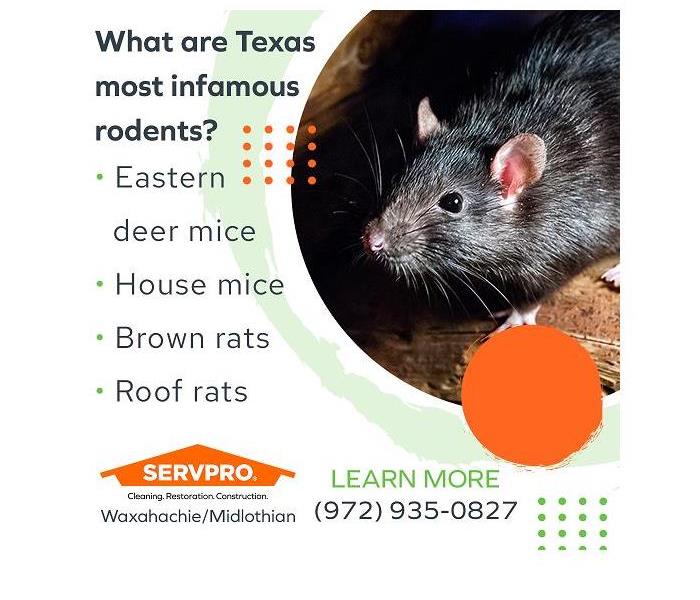How Rodents Can Cause Electrical Fires and Fire Damage in Midlothian, TX, Homes
11/8/2022 (Permalink)
Blog Summary: SERVPRO® of Waxahachie/Midlothian warns the local community about the connection between electrical fires and the presence of rodents in the home.
Fire damage may often result in the need for water removal and water damage restoration. In Midlothian, TX, homes, fire can result from a variety of causes, and one of these causes is the failure of or damage to the home’s electrical components. A sometimes overlooked contributor to electrical fires in the home is rodents. The experts at PestWorld.org, the official consumer education website of the National Pest Management Association (NPMA), estimate that “rodents are responsible for 20 percent to 25 percent of all fires of unknown causes because of their propensity for chewing electrical wiring and gas lines.”
Rodents often gnaw on housing materials, such as wiring, insulation, and pipes, because these pests need to be constantly filing down their teeth. If a rodent’s teeth grow too long, the animal will be unable to eat. Once rats or mice chew through the protective plastic insulation covering the electrical wires, the metal is exposed, and sparks from a shorted circuit or heat from the live wire could ignite a fire if the homeowner does not discover the damaged wiring in time. Rodent nests and debris caused by rodent activity can become the fuel that touches off a destructive house fire.
The rodent roundup: What are Texas’ most infamous rodents?
While Texas is home to many different types of rodents, four pests are the most notable: the eastern deer mouse, the house mouse, the brown rat, and the roof rat.
Eastern deer mice (Peromyscus maniculatus)
These native Texas rodents can be found throughout Lone Star State, especially in rural areas. Their white and brown coloration resembles that of a deer, hence the name ‘deer mice.’ Eastern deer mice are nocturnal and can reach a size of around three to four inches long, not including the mouse’s tail. When they enter homes, they often do so in order to build a nest.
House mice (Mus musculus)
Although house mice are not native to Texas, they are present throughout the entire state. Like eastern deer mice, they are nocturnal, but they are also active during the daytime. Adults can grow to three to four inches, excluding the tail. House mice are prolific breeders, so eradicating them from a house they have infested can be a challenging task. By the time the pest control company or exterminator has remediated the infestation, the home may have sustained extensive damage.
Brown rats (Rattus norvegicus)
The brown rat, also known as the common rat, the Norway rat, the street rat, or the sewer rat, is one of Texas’ largest pests, reaching an adult body length of seven to nine inches. The species is not native to the area, but they are present in most of Texas, although they are more commonly seen in the north of the state. Brown rats reproduce at a rapid rate.
Roof rats (Rattus rattus)
Alternatively known as the black rat or the house rat, the roof rat is a skilled climber and can make its way to the roof, the rafters, or the attic. Roof rats like to stay in populated areas and can gnaw through a variety of household materials such as wood, drywall, aluminum siding, and electrical wiring. In terms of size, they can grow to a length of six to eight inches, not including the length of the tail. According to PestWorld.org, “Roof rats only live up to one year but have the ability to produce as many as 40 new offspring during their lifetime.”
The two calls homeowners need to make
When a rodent infestation is suspected or detected, the homeowner will need to call in the services of a professional pest control company or wildlife exclusion company that can safely resolve the problem. In addition to dealing with the current rodent problem, a wildlife exclusion service will identify and seal up rodent access points so that the pests do not return to the home.
The second call is to a fire damage restoration company. In the event that rodents have caused fire damage to the home, the services of a restoration company will be essential to remediate the damage and return life to a sense of normalcy. However, it is recommended that homeowners prequalify a full-service damage restoration company before a disaster strikes in order to minimize stress and provide a clear plan of action in case of property damage.
Contact SERVPRO® of Waxahachie/Midlothian to learn more about fire damage restoration, water damage restoration, and water removal services in Midlothian, TX. The office can be reached by email at acarey@SERVPRO10932.com or by phone at (972) 935-0827.



 24/7 Emergency Service
24/7 Emergency Service
